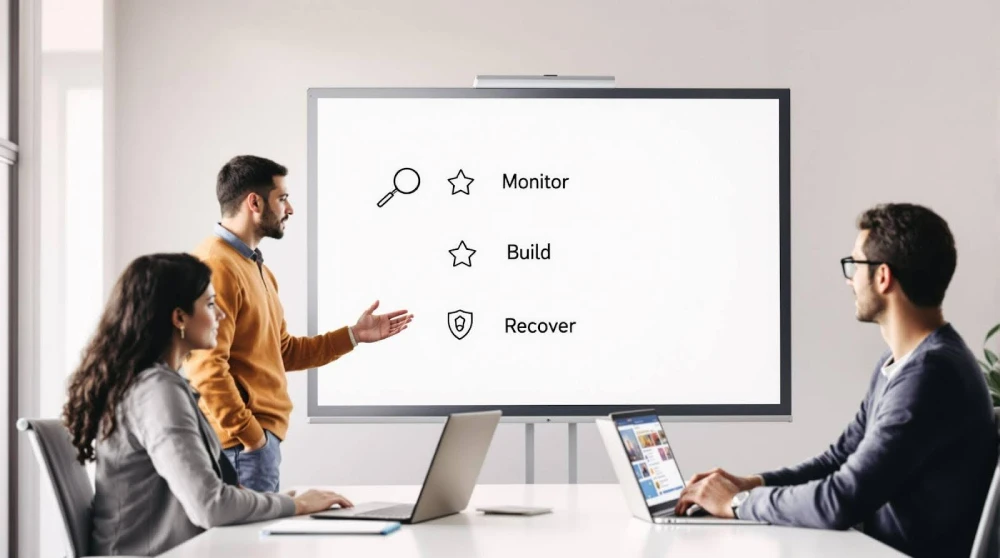The Three Phases of Reputation Management
Online reputation management consists of three essential phases: monitoring, responding, and building credibility.
The first step involves actively tracking your brand’s online presence to identify any mentions or reviews. After gathering this feedback, it is crucial to respond promptly and thoughtfully, demonstrating that you value customer input.
The final phase focuses on building credibility through nurturing long-term relationships with customers, which can lead to enhanced loyalty. Stay engaged with these strategies to effectively strengthen your brand’s reputation.
Key Takeaways
- Monitoring: Continuously track online mentions, reviews, and feedback to understand public perception and identify potential issues early on.
- Response Management: Address both positive and negative feedback promptly to show engagement and enhance brand credibility.
- Crisis Preparedness: Develop a plan to respond to negative situations transparently and effectively, ensuring accountability and working to restore trust.
- Engagement: Maintain ongoing dialogue with customers through various channels, strengthening relationships and addressing concerns proactively.
- Continuous Improvement: Analyze feedback to prioritize customer needs and create a roadmap for enhancements, ensuring long-term brand loyalty.
Importance of Monitoring in Reputation Management
In today’s digital landscape, monitoring your online reputation is essential for safeguarding your brand image. By responding promptly to negative feedback, you can influence potential customers, as 80% of consumers are deterred from making a purchase based on unfavorable reviews. With 90% of individuals reading online reviews prior to visiting a business, your reputation plays a crucial role in shaping their decisions.
Engaging with customer feedback not only enhances your credibility but also demonstrates that you value their perceptions. Effective monitoring enables you to identify positive comments that can be leveraged for marketing purposes. It’s important to note that companies with a strong online reputation typically receive 6.9 times more leads. Additionally, 93% of customers report greater satisfaction when management actively responds to reviews. By utilizing monitoring tools, businesses can strategically track their online presence and swiftly address any emerging issues.
Prioritizing reputation monitoring is vital for achieving long-term business success. By staying informed and responsive, you can build a positive online presence that resonates with your audience.
Protect your brand start reputation management now
Tools for Effective Monitoring
Effective monitoring is crucial for maintaining a strong brand presence. Utilizing social media monitoring tools allows you to track brand mentions and gauge sentiment, ensuring you stay informed about public perception. Real-time alerts keep you updated on any significant developments.
Review management software enables you to monitor customer feedback, helping you enhance your brand’s reputation and address concerns promptly. These tools not only provide valuable insights but also empower you to respond effectively to your audience’s needs. Online reputation management tools are essential for all business sizes, as they help maintain loyal customers and create more business opportunities.
Social Media Monitoring Tools
As social media increasingly influences brand perception, it is crucial to employ effective monitoring tools to manage your online reputation. Real-time monitoring enables prompt responses to brand mentions, while sentiment analysis provides insight into how your audience perceives your brand. Seek tools that integrate smoothly with your CRM systems and email marketing platforms for a comprehensive approach. Reputation monitoring tools can help you identify and analyze the tone and context of brand mentions, ensuring a deeper understanding of public sentiment.
Detailed analytics and reporting features are essential for tracking performance, identifying trends, and observing competitor activity. Visual content monitoring, including image recognition, can significantly enhance brand awareness. With these capabilities, you can take proactive steps to address potential crises before they escalate, while also gaining insights to refine your strategy. Investing in the right monitoring tools will help you maintain a strong online presence and effectively engage with your audience.
Alerts for Brand Mentions
Effective alerts for brand mentions are crucial for managing your online reputation. Utilizing the right tools enables you to monitor your brand’s visibility and respond promptly to feedback. Here are three noteworthy tools to consider:
- Mention: This tool provides real-time alerts across social media and various websites, along with basic sentiment analysis to help you gauge public perception.
- Google Alerts: A free service that scans Google search results for your specified brand keywords, offering customizable notifications to keep you informed.
- Buzzsumo Alerts: With this tool, you can receive daily email summaries of brand mentions in content, allowing you to configure multiple alerts to suit your needs. Additionally, brand monitoring tools can transform mentions into actionable insights for managing online reputation.
Review Management Software
Monitoring brand mentions is an essential step in maintaining a positive online reputation. Review management software enhances this process by centralizing reviews from various platforms, allowing you to efficiently monitor and respond to customer feedback. With tools such as automated review requests, you can encourage a higher volume of feedback from your customers. This software not only saves you valuable time but also boosts customer engagement through prompt responses.
In addition, you will gain useful insights from analytics, helping you identify trends and areas for improvement. Effectively managing negative reviews is crucial for enhancing your online reputation. When selecting the right tool, consider factors like integration capabilities and user interface to ensure it aligns with your business needs.
Strategies for Comprehensive Monitoring
To effectively manage your reputation, it is essential to implement strong monitoring strategies. Real-time tracking and comprehensive coverage techniques will enable you to stay informed about customer sentiments and feedback. By utilizing the appropriate tools, you can receive timely notifications and observations, allowing you to respond quickly to any concerns that may arise. This proactive approach not only protects your brand image but also demonstrates your commitment to customer satisfaction.
Tools for Effective Monitoring
Managing your brand’s reputation may seem challenging, but utilizing the right tools can make the process much easier. Here are three effective monitoring tools to consider:
- Meltwater: This tool integrates social listening with sentiment analysis, offering a comprehensive view of your brand mentions across various platforms. It helps you understand how your audience perceives your brand.
- Reputology: This platform allows you to monitor reviews from multiple sites such as Yelp and Google in one place, making review management straightforward and efficient.
- Brand24: This tool tracks brand mentions across social media, news outlets, and blogs. It provides detailed analytics to help you gain insights into public perception and respond appropriately.
Real-Time Tracking Strategies
Effective tools for monitoring your brand’s reputation lay the groundwork for implementing real-time tracking strategies. By adopting these strategies, you can quickly identify and respond to emerging issues, helping to prevent potential crises. This swift response not only safeguards your brand’s integrity but also builds customer trust—research indicates it can increase trust by as much as 45%.
Real-time tracking enables you to observe market trends and consumer sentiments, providing you with a competitive edge. Engaging with customers in a timely manner enhances their loyalty and turns feedback into opportunities for improvement. With ongoing monitoring, you can adjust your strategies to adapt to changing market conditions, ensuring your brand sustains a positive perception and strong market position.
Comprehensive Coverage Techniques
Effective reputation management relies on thorough coverage techniques that allow you to monitor your brand’s presence across various platforms with ease. By implementing these strategies, you can stay informed about public perceptions of your brand and respond in a timely manner.
Consider these three key strategies to enhance your monitoring efforts:
- Brand Monitoring: Utilize tools like Google Alerts and social listening platforms to keep track of mentions and reviews of your brand.
- Digital Footprint Analysis: Regularly check blogs and social media, monitor relevant keywords, and analyze sentiment to understand how the public perceives your brand.
- Integrated Data Sources: Combine insights from different platforms and tools to develop a comprehensive understanding of your brand’s reputation.
The Role of Responding in Reputation Management
Responding promptly to feedback is crucial for effectively managing your brand’s reputation. Timely responses not only address customer concerns but also help create a genuine connection with your audience. By replying quickly to reviews, you demonstrate attentiveness and care, which contributes to a positive brand image. Ignoring feedback can lead to perceptions of neglect and diminish customer trust.
A prompt reply, ideally within 24 hours, can help turn negative experiences into positive outcomes and enhance customer satisfaction. This level of engagement reflects professionalism and a commitment to your customers. By consistently addressing both positive and negative reviews, you enhance customer loyalty and gain valuable insights for future improvements. Ultimately, how you respond shapes potential customers’ perceptions of your brand.
Effective Response Strategies to Customer Feedback
Building on the importance of timely responses, having a clear approach for addressing customer feedback can significantly enhance your brand’s reputation. Here are three effective response strategies you can implement:
- Close the feedback loop: Acknowledge all comments, explain the actions taken in response, and invite ongoing discussion for any negative feedback received. This demonstrates that you value customer input.
- Engage through multiple channels: Utilize surveys, social media, and email to collect diverse feedback. Make it easy for customers to share their thoughts, ensuring every voice is heard.
- Analyze and implement: Identify common issues from the feedback, prioritize customer needs, and create a roadmap for improvements. This helps you focus on what matters most to your customers.
Tools for Efficient Response Management
Effective response management relies on the right tools to enhance communication and improve customer engagement. Automated response systems such as Sprout Social and BirdEye offer chatbots and review management features that save time and boost efficiency. Real-time alerts from Mention and AppFollow enable you to monitor your brand’s reputation closely, ensuring you are informed of any issues as they arise.
Centralized dashboards from Broadly and Sprout Social facilitate seamless collaboration within your team, making it easier to respond promptly. Lastly, AI-driven insights from platforms like BirdEye and Podium analyze sentiment and automate responses, providing a clearer understanding of public perception. By integrating these tools, you can effectively manage your reputation in today’s fast-paced environment.
Building Brand Credibility and Loyalty
As you navigate the competitive landscape, establishing brand credibility and loyalty is vital for long-term success. Here are three key strategies to implement:
- Deliver Quality: Consistently provide high-quality products or services. Implement quality control measures and focus on exceeding customer expectations. It’s important to note that 32% of customers may choose to leave after just one negative experience.
- Engage with Your Audience: Develop a strong social media presence. Respond promptly to comments, share meaningful content, and encourage customer reviews. Show the human side of your brand by offering behind-the-scenes insights.
- Be Transparent and Authentic: Acknowledge your mistakes and ensure your actions align with your stated values. Share customer feedback to demonstrate that you value their input. Authenticity builds trust, increasing the likelihood that customers will remain loyal.
Methods for Engaging and Building Relationships
To effectively engage and build relationships, it is essential to implement content creation strategies and social media techniques. By developing meaningful content that resonates with your audience and actively participating on social platforms, you can strengthen your connection with customers. This strategy not only improves your brand’s reputation but also encourages loyalty and trust. By prioritizing user-centered approaches, you can ensure that your insights and guidance are valuable and supportive.
Content Creation Strategies
How can you create content that not only engages your audience but also builds lasting relationships? Start by prioritizing quality and consistency. When you consistently deliver high-quality content that addresses your audience’s challenges, you build trust and credibility. Here are three effective strategies to implement:
- Educational Articles: Provide informative content that positions you as an authority in your industry while meeting the needs of your audience.
- Engaging Videos: Produce captivating videos that resonate with your audience, encouraging interaction and connection.
- Customer Testimonials: Highlight positive reviews to strengthen your brand’s reputation and build trust with potential customers.
Social Media Engagement Techniques
Social media serves as a powerful tool for engaging with your audience and establishing enduring relationships. The key lies in interactivity and authenticity. Consider incorporating interactive content such as quizzes, polls, and contests to invite participation from your audience. Hosting live Q&A sessions can create memorable experiences and allow for real-time engagement. It is important to respond promptly to comments, demonstrating that you value your audience’s input.
Encouraging user-generated content can make your followers feel included and valued. Sharing high-quality visuals, GIFs, and even memes can help convey your brand’s personality in an approachable manner. Regularly updating your content and monitoring brand mentions will keep you responsive to your audience’s needs. By nurturing genuine connections and maintaining consistency, you will enhance engagement and strengthen your brand’s reputation effectively.
Best Practices for Continuous Reputation Improvement
Maintaining a positive reputation can be a challenging endeavor. However, by implementing best practices aimed at continuous improvement, you can significantly enhance your brand’s image. Here are three effective strategies to consider:
- Regular Customer Surveys: Collect feedback on your strengths and areas for growth. This will help you gain a clearer understanding of customer expectations and needs.
- Encourage and Respond to Reviews: Actively promote positive reviews while addressing negative feedback in a constructive manner. This approach builds trust and demonstrates your commitment to customer satisfaction.
- Transparency and Authenticity: Communicate openly about both your successes and setbacks. Showing accountability fosters a deeper connection with customers and enhances their trust in your brand.
Case Studies in Crisis and Customer Service Management
Crisis situations can arise without warning, and a company’s response can greatly influence its reputation. Consider the example of Domino’s Pizza, which encountered significant challenges due to product quality complaints. They successfully navigated this crisis by launching a transparent advertising campaign and revamping their product offerings.
Similarly, during the Tylenol crisis, Johnson & Johnson placed a strong emphasis on customer safety, establishing a benchmark for crisis management in the industry. In another instance, a hedge fund CEO addressed misinformation by producing valuable financial content, successfully mitigating negative online narratives.
These cases demonstrate that proactive strategies and a customer-centric focus are essential for rebuilding trust and restoring reputation. By studying these examples, businesses can better prepare for potential crises, ensuring a prompt and effective response that prioritizes customer needs.
Conclusion
In summary, excelling in the three phases of reputation management—monitoring, responding, and improving—will enable you to protect and enhance your brand’s image. By using effective tools and strategies, you can promptly address customer feedback and cultivate lasting relationships. Your brand’s credibility and loyalty depend on how you engage with your audience. Keep refining your approach, learn from real-world examples, and watch your reputation thrive in today’s competitive landscape.
Managing your online reputation is essential for business growth. A digital marketing agency can monitor, protect, and enhance your brand’s image to build trust and credibility. Take control of your reputation before others define it for you—contact us to start today!
Take control of your online image today
FAQs
Why are the three phases essential for improving your online reputation?
Focusing on the three phases strengthens your presence on review sites, boosts SEO, and enhances visibility on platforms like LinkedIn. By monitoring search engine results, you elevate brand reputation management and refine your reputation management strategy. Embracing the 3 pillars of brand reputation ensures alignment with the pillars of brand reputation management for effective long-term results.
How does online reputation management differ from traditional PR tactics?
Implementing a solid management process alongside social media management helps you master the 3 pillars of successful engagement. Complement this with reputation management services to handle critical feedback. Since reputation management is the process of safeguarding trust, optimizing social profiles and social media profiles is key to maintaining your online reputation across all digital touchpoints.
What key elements define effective brand reputation management across multiple channels?
Building your online credibility starts with consistent content about your brand and understanding all parts of online reputation management. To manage your online reputation effectively, focus on creating a positive brand reputation through timely review management. By tracking how your reputation online evolves, you gain insights into how your audience views your brand in the market.
How do I develop a solid reputation management strategy that addresses customer feedback?
Begin with a thorough process of monitoring to pinpoint threats and employ risk management strategies. Remember, brand reputation management isn’t a quick fix; it requires ongoing improvement of your brand’s online channels. Make sure you’re listening to your brand’s customers, as recovering your online reputation often hinges on prompt and respectful responses to customer feedback.
In what ways do the 3 pillars of brand reputation and pillars of brand reputation management overlap?
Tracking every social mention is crucial, as it affects the reputation of a company directly. Online mentions can make or break how others perceive you. Strengthen trust with positive content about your brand while managing both positive and negative reviews. Identifying next steps helps maintain a good reputation and ensures consistent brand messaging.
What are the best practices for maintaining your online reputation amid challenging market shifts?
Use sites like specialized review platforms and monitor social media channels to detect a negative reputation early. At any stage of reputation awareness, tools like Google Alerts can help. Remember, online reputation matters, so consider hiring a reputation management company for effective online reputation management when in-house resources aren’t enough to protect your brand image.
How can businesses identify the most critical parts of online reputation management for growth?
Reputation management efforts involve encouraging customers to leave feedback and carefully tracking mentions of your brand. These insights help you identify both strengths and weaknesses. Positive word of mouth grows when you understand what’s being said about your brand. Since trust can take years to build, monitoring and influencing perception is critical for sustained success.
Why is building your online presence crucial for customer trust in today’s competitive landscape?
Providing customers with the information they need is crucial to maintaining trust. Always respond to customer inquiries promptly, because monitoring your reputation ensures a healthy brand online. For an online business, proactive steps can build your reputation and foster a positive online reputation. Ultimately, a strong online reputation management strategy boosts customer confidence and loyalty.
Which phase of reputation management should I focus on first to effectively manage your online reputation?
Reputation management is often influenced by content on social media. Using tools like Google Alerts helps spot problems early. Your website is your online foundation, so track inbound social messages you receive across social platforms. Conduct brand surveys and complete an initial brand audit to gauge sentiment in your business and industry for improvement opportunities.
Are there proven techniques for recovering your online reputation after significant public backlash?
Recovering your online reputation requires clarity around your brand and audience. Use social media sites and other social media platforms as part of your marketing strategy to share positive content online and reestablish a strong brand presence. Employ suppression strategies if necessary, ensuring your company name dominates search results and effectively reshapes public perception.







